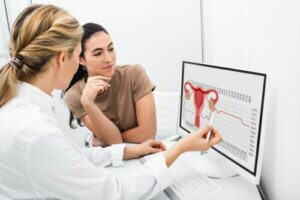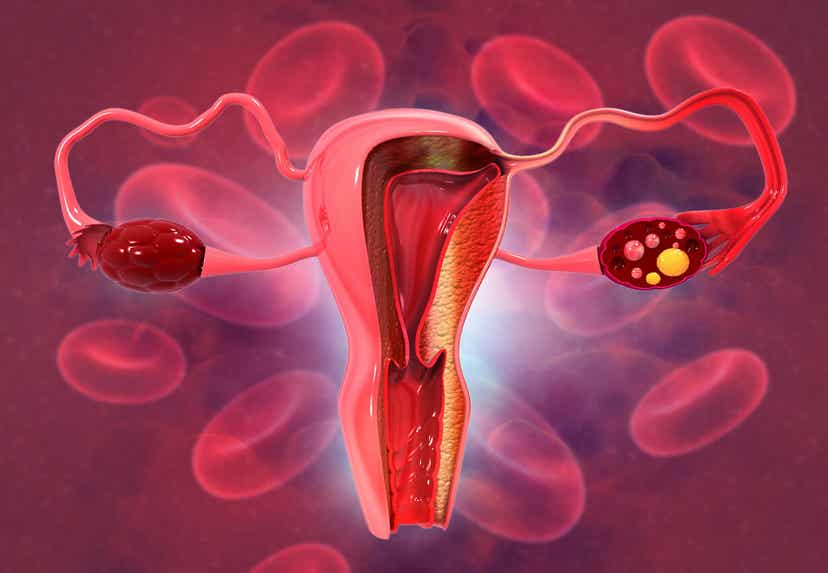The Role of Ovulation in Female Reproduction

Ovulation is a process that most of us have heard of, but few of us understand exactly what it entails and what the role of ovulation is in female reproduction. That’s why we want to present the following article, in which you’ll learn what factors ovulation depends on and what happens before, during, and after it takes place.
The hormonal and anatomical factors that it involves vary greatly and many elements can influence them. In such cases, fertility problems may arise. So, if you suspect such a problem, it’s important to see a doctor as soon as possible.
What is ovulation and what factors does it depend on?

Ovulation’s a complex process that involves the release of oocytes from the ovaries during each menstrual cycle. This process depends on both anatomical and hormonal factors. Far from being a procedure limited to the ovaries, it actually involves numerous substances that also act on other areas of the female reproductive system.
From an anatomical point of view, ovulation occurs from structures known as ovarian follicles. These are the female gonads and there’s one on each side of the uterus. When the follicles rupture, they release a cell that will progressively differentiate into an ovum.
Hormonal factors are numerous and, from a functional point of view, the hypothalamus-pituitary-ovary axis is very important. All of these organs are glands capable of releasing hormones that participate directly in the menstrual cycle; some are also relevant during pregnancy.
Find out more: Interesting Facts About Menstrual Cycles and Conception
What’s the role of ovulation and how does it take place?
For practical purposes, we’ll explain what happens before, during, and after ovulation. In this whole process, the role of hormones is fundamental, especially those we described in the above-mentioned axis.
Before
Did you know that from the moment of their birth, girls have millions of immature sex cells? Of course, this is a measure to preserve the fertility of the species as well as possible. However, all these cells may never become useful.
Therefore, as the years go by, most of these cells undergo a process of degeneration or death known as atresia. So, only a few oocytes capable of developing properly will remain in each ovary. However, in most cases, they’re sufficient during fertile life.
During
When women enter reproductive age, the effects of hormones become evident. These are produced during each menstrual cycle and the pre-ovulatory phase occurs thanks to an increase in the blood concentration of luteinizing hormones (LH) and follicle stimulating hormones (FSH).
The pituitary gland, or hypophysis, releases these substances due to stimulation by gonadotropin-releasing hormone (GnRH) from the hypothalamus. The action of LH and FSH induces changes in the ovaries, which will gradually lead to the rupture of the ovarian follicle.
This last process is what we actually refer to as ovulation. The oocyte will progressively move down the uterine tubes, “waiting” for the arrival of a sperm for fertilization.
Find out more: How Fertilization Occurs: The Miracle of Life, Step by Step

After
When the ovarian follicle has completed the release of the oocyte, the process of the formation of the corpus luteum progressively begins on the surface of the ovary. This, far from being a remnant of the ovulation process, is an active structure capable of secreting the hormones that are important for a possible pregnancy.
The latter are progesterone and estrogens, which are very important for preparing the uterus for the growth of the embryo in the coming weeks, should fertilization occur. As you can see, the role of ovulation is essential when it comes to female reproduction.
Final recommendations
Due to its complexity, ovulation can be influenced by a variety of factors, such as polycystic ovary syndrome. For this reason, it’s important to have adequate gynecological health, especially when you want to have children. If you have any doubts about this, the best thing to do is to schedule an appointment with your gynecologist and follow healthy lifestyle habits.
https://youaremom.com/health/first-visit-to-the-gynecologist/
https://eresmama.com/que-es-ovulacion/
Ovulation is a process that most of us have heard of, but few of us understand exactly what it entails and what the role of ovulation is in female reproduction. That’s why we want to present the following article, in which you’ll learn what factors ovulation depends on and what happens before, during, and after it takes place.
The hormonal and anatomical factors that it involves vary greatly and many elements can influence them. In such cases, fertility problems may arise. So, if you suspect such a problem, it’s important to see a doctor as soon as possible.
What is ovulation and what factors does it depend on?

Ovulation’s a complex process that involves the release of oocytes from the ovaries during each menstrual cycle. This process depends on both anatomical and hormonal factors. Far from being a procedure limited to the ovaries, it actually involves numerous substances that also act on other areas of the female reproductive system.
From an anatomical point of view, ovulation occurs from structures known as ovarian follicles. These are the female gonads and there’s one on each side of the uterus. When the follicles rupture, they release a cell that will progressively differentiate into an ovum.
Hormonal factors are numerous and, from a functional point of view, the hypothalamus-pituitary-ovary axis is very important. All of these organs are glands capable of releasing hormones that participate directly in the menstrual cycle; some are also relevant during pregnancy.
Find out more: Interesting Facts About Menstrual Cycles and Conception
What’s the role of ovulation and how does it take place?
For practical purposes, we’ll explain what happens before, during, and after ovulation. In this whole process, the role of hormones is fundamental, especially those we described in the above-mentioned axis.
Before
Did you know that from the moment of their birth, girls have millions of immature sex cells? Of course, this is a measure to preserve the fertility of the species as well as possible. However, all these cells may never become useful.
Therefore, as the years go by, most of these cells undergo a process of degeneration or death known as atresia. So, only a few oocytes capable of developing properly will remain in each ovary. However, in most cases, they’re sufficient during fertile life.
During
When women enter reproductive age, the effects of hormones become evident. These are produced during each menstrual cycle and the pre-ovulatory phase occurs thanks to an increase in the blood concentration of luteinizing hormones (LH) and follicle stimulating hormones (FSH).
The pituitary gland, or hypophysis, releases these substances due to stimulation by gonadotropin-releasing hormone (GnRH) from the hypothalamus. The action of LH and FSH induces changes in the ovaries, which will gradually lead to the rupture of the ovarian follicle.
This last process is what we actually refer to as ovulation. The oocyte will progressively move down the uterine tubes, “waiting” for the arrival of a sperm for fertilization.
Find out more: How Fertilization Occurs: The Miracle of Life, Step by Step

After
When the ovarian follicle has completed the release of the oocyte, the process of the formation of the corpus luteum progressively begins on the surface of the ovary. This, far from being a remnant of the ovulation process, is an active structure capable of secreting the hormones that are important for a possible pregnancy.
The latter are progesterone and estrogens, which are very important for preparing the uterus for the growth of the embryo in the coming weeks, should fertilization occur. As you can see, the role of ovulation is essential when it comes to female reproduction.
Final recommendations
Due to its complexity, ovulation can be influenced by a variety of factors, such as polycystic ovary syndrome. For this reason, it’s important to have adequate gynecological health, especially when you want to have children. If you have any doubts about this, the best thing to do is to schedule an appointment with your gynecologist and follow healthy lifestyle habits.
https://youaremom.com/health/first-visit-to-the-gynecologist/
https://eresmama.com/que-es-ovulacion/
All cited sources were thoroughly reviewed by our team to ensure their quality, reliability, currency, and validity. The bibliography of this article was considered reliable and of academic or scientific accuracy.
- Knudtson J, et al. Ciclo menstrual. Manual MSD. Disponible en: https://www.msdmanuals.com/es-ve/hogar/salud-femenina/biolog%C3%ADa-del-aparato-reproductor-femenino/ciclo-menstrual?query=Endocrinolog%C3%ADa%20reproductiva%20femenina
This text is provided for informational purposes only and does not replace consultation with a professional. If in doubt, consult your specialist.








